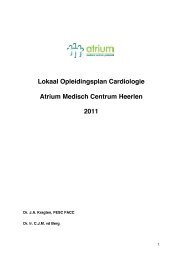Guidelines on the Management of Stable Angina Pectoris ... - Cardio
Guidelines on the Management of Stable Angina Pectoris ... - Cardio
Guidelines on the Management of Stable Angina Pectoris ... - Cardio
You also want an ePaper? Increase the reach of your titles
YUMPU automatically turns print PDFs into web optimized ePapers that Google loves.
ESC <str<strong>on</strong>g>Guidelines</str<strong>on</strong>g> 41PCI may be c<strong>on</strong>sidered for mildly symptomatic patients in<strong>the</strong> category <strong>of</strong> higher-risk ischaemia and severe anatomicCAD <strong>on</strong>ly if <strong>the</strong>re is a high likelihood <strong>of</strong> success and a lowrisk <strong>of</strong> morbidity or mortality.Specific patient and lesi<strong>on</strong> subsetsPatients with severely depressed LV functi<strong>on</strong> and/or highsurgical risk. Patients in whom surgical risk is prohibitivelyhigh may benefit from revascularizati<strong>on</strong> by PCI, particularlywhen residual viability can be dem<strong>on</strong>strated in <strong>the</strong> dysfuncti<strong>on</strong>ingmyocardium perfused by <strong>the</strong> target vessel(s). Thisissue is currently addressed in two large randomizedstudies, <strong>the</strong> STICH 603 and <strong>the</strong> HEART UK 604 trials.Unprotected LM disease. The LM stem is referred to asunprotected when <strong>the</strong> distal cor<strong>on</strong>ary arteries do notreceive circulati<strong>on</strong> from a bypass graft. Several observati<strong>on</strong>alreports 605,606 indicate <strong>the</strong> feasibility <strong>of</strong> PCI in LMstem disease. More recently, an observati<strong>on</strong>al registry hasshown improved results with drug eluting compared withbare metal stents 607 holding promise for <strong>the</strong> use <strong>of</strong> PCI inLM stem disease in <strong>the</strong> future. However, surgery shouldremain <strong>the</strong> preferred approach until <strong>the</strong> outcome <strong>of</strong>fur<strong>the</strong>r trials are known.Multi-vessel disease in patients with diabetes. Aformaltrialcomparing <strong>the</strong> effect <strong>of</strong> PCI vs. CABG in diabetics is not yetavailable; however, post hoc subgroup analyses <strong>of</strong> randomizedtrials comparing <strong>the</strong>se treatment strategies have shownreduced mortality with bypass surgery compared withPCI. 608,609 The BARI trial was <strong>the</strong> largest <strong>of</strong> <strong>the</strong>se trials and<strong>the</strong> <strong>on</strong>ly in which a statistical difference in mortality wasdetected between <strong>the</strong> treatment groups in <strong>the</strong> diabetics. 590,610Am<strong>on</strong>g treated diabetics (n ¼ 353), <strong>the</strong>re was an absolutesurvival advantage <strong>of</strong> 15% for CABG at 5 years (P ¼ 0.003).The rate <strong>of</strong> repeat revascularizati<strong>on</strong> was also higher with PCIin diabetics in BARI and was evident too even withstent-assisted PCI (41 vs. 8.4%) in <strong>the</strong> ARTS study.A limitati<strong>on</strong> <strong>of</strong> <strong>the</strong>se trials is that <strong>the</strong>y were c<strong>on</strong>ductedbefore <strong>the</strong> widespread use <strong>of</strong> drug-eluting stents or adjuvantperi-procedural antiplatelet <strong>the</strong>rapy. Drug-eluting stentshave reduced <strong>the</strong> rate <strong>of</strong> restenosis in diabetic as in n<strong>on</strong>diabeticpatients 585,586,611 but <strong>the</strong> impact <strong>of</strong> this reducti<strong>on</strong><strong>on</strong> mortality in diabetic patients, particularly in multi-vesselPCI, is unknown. Two major trials are underway to addressthis important issue, BARI 2 Diabetes (BARI 2D) andFREEDOM (Future Revascularisati<strong>on</strong> Evaluati<strong>on</strong> in Patientswith Diabetes Mellitus). However, for <strong>the</strong> present, due c<strong>on</strong>siderati<strong>on</strong>should be given to <strong>the</strong> evidence available and PCIshould be used with reservati<strong>on</strong> in diabetics with multivesseldisease until <strong>the</strong> results <strong>of</strong> fur<strong>the</strong>r trials are known.Patients with previous bypass graft surgery. There are norandomized c<strong>on</strong>trolled trials comparing treatment opti<strong>on</strong>sin patients with previous bypass surgery. Observati<strong>on</strong>aldata suggest that patients with late stenoses <strong>of</strong> vein graftshave a high mortality rate, 612 and re-operati<strong>on</strong> improved<strong>the</strong> outcome <strong>of</strong> <strong>the</strong>se patients in <strong>on</strong>e observati<strong>on</strong>al comparis<strong>on</strong>.613 Redo surgery may be undertaken <strong>on</strong> symptomaticgrounds where <strong>the</strong> anatomy is suitable. However, <strong>the</strong> operativerisk <strong>of</strong> redo bypass surgery is as high as three-foldgreater than initial surgery, 614 and for those with a patentITA graft, <strong>the</strong>re is <strong>the</strong> additi<strong>on</strong>al risk <strong>of</strong> damage to thisgraft during surgery.In c<strong>on</strong>trast, PCI can be performed following previous surgicalrevascularizati<strong>on</strong>, ei<strong>the</strong>r in <strong>the</strong> vein graft or arterialgraft, or <strong>the</strong> native cor<strong>on</strong>ary tree bey<strong>on</strong>d <strong>the</strong> graft whichis not revascularized, and may provide a useful alternativeto redo surgery for symptomatic relief. Protective filterdevices may be employed to reduce particulate debrisfrom embolizing downstream and causing peri-proceduralmyocardial damage (SAFER) 615 when dilating old saphenousvein grafts.Chr<strong>on</strong>ic total occlusi<strong>on</strong>s. Chr<strong>on</strong>ic total occlusi<strong>on</strong>s still represent<strong>the</strong> most frequent mode <strong>of</strong> failure <strong>of</strong> PCI. When <strong>the</strong>occlusi<strong>on</strong> can be crossed with a guide-wire and <strong>the</strong> distallumen has been reached, satisfactory results are obtainablewith stent implantati<strong>on</strong>, as shown by several trials, 616–618albeit at <strong>the</strong> expense <strong>of</strong> high restenosis rate ranging from32 to 55%. The value <strong>of</strong> drug-eluting stents in this respectis currently under evaluati<strong>on</strong>. In patients with multi-vesseldisease, failure to treat chr<strong>on</strong>ic total occlusi<strong>on</strong>s will resultin incomplete revascularizati<strong>on</strong>, which could be avoidedwhen <strong>the</strong> patient is referred for bypass surgery.Indicati<strong>on</strong>s for revascularizati<strong>on</strong>In general, patients who have indicati<strong>on</strong>s for cor<strong>on</strong>ary arteriographyand in whom ca<strong>the</strong>terizati<strong>on</strong> reveals severe cor<strong>on</strong>aryartery stenosis are also potential candidates formyocardial revascularizati<strong>on</strong>. In additi<strong>on</strong>, a patient is potentiallyeligible for revascularizati<strong>on</strong> if:(1) medical <strong>the</strong>rapy is unsuccessful in c<strong>on</strong>trolling symptomsto <strong>the</strong> patient’s satisfacti<strong>on</strong>(2) n<strong>on</strong>-invasive tests reveal a substantial area <strong>of</strong> myocardiumat risk(3) <strong>the</strong>re is a high likelihood <strong>of</strong> success and acceptable risk<strong>of</strong> morbidity and mortality(4) <strong>the</strong> patient prefers an interventi<strong>on</strong>al ra<strong>the</strong>r than amedical approach and is fully informed <strong>of</strong> <strong>the</strong> risks <strong>of</strong>this route <strong>of</strong> <strong>the</strong>rapy in <strong>the</strong>ir individual caseAn adequate resp<strong>on</strong>se to <strong>the</strong>rapy must be judged in c<strong>on</strong>sultati<strong>on</strong>with <strong>the</strong> patient. For some, Class I symptoms(angina <strong>on</strong>ly <strong>on</strong> strenuous exerti<strong>on</strong> but not during ordinaryactivity) are acceptable, but o<strong>the</strong>rs may wish for completeaboliti<strong>on</strong> <strong>of</strong> <strong>the</strong>ir symptoms. Recommendati<strong>on</strong>s for revascularizati<strong>on</strong><strong>on</strong> symptomatic grounds, as summarized in Table 8or below, have taken into account <strong>the</strong> range <strong>of</strong> symptomaticgrades for which evidence is available and should be c<strong>on</strong>struedin this fashi<strong>on</strong> ra<strong>the</strong>r than as a directive to performrevascularizati<strong>on</strong> across <strong>the</strong> entire range <strong>of</strong> symtomatology.What is an acceptable risk <strong>of</strong> morbidity and mortality shouldalso be c<strong>on</strong>sidered <strong>on</strong> an individual basis for each patient.Ideally, patients should not be advised to have a procedurefor which <strong>the</strong> procedural mortality exceeds <strong>the</strong>ir estimatedannual mortality unless <strong>the</strong>re is evidence <strong>of</strong> substantialprognostic benefit in <strong>the</strong> l<strong>on</strong>ger term or symptoms arehaving a serious impact <strong>on</strong> <strong>the</strong>ir quality <strong>of</strong> life, despiteappropriate medical <strong>the</strong>rapy.Selecti<strong>on</strong> <strong>of</strong> <strong>the</strong> method <strong>of</strong> revascularizati<strong>on</strong> should bebased <strong>on</strong>:(1) risk <strong>of</strong> peri-procedural morbidity and morbidity(2) likelihood <strong>of</strong> success, including factors such as technicalsuitability <strong>of</strong> lesi<strong>on</strong>s for angioplasty or surgicalbypass(3) risk <strong>of</strong> restenosis or graft occlusi<strong>on</strong>














